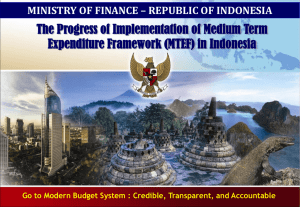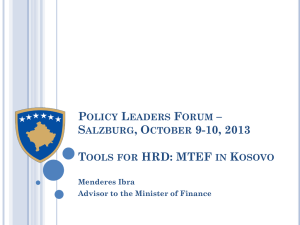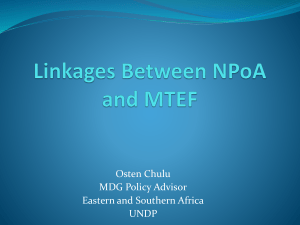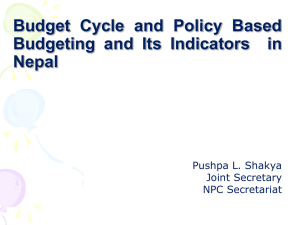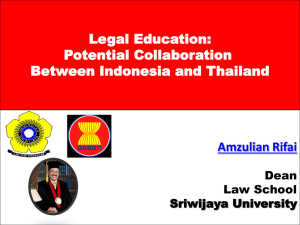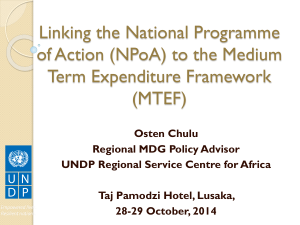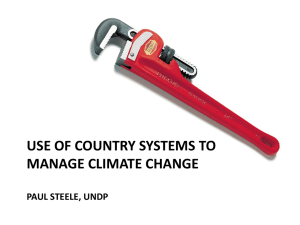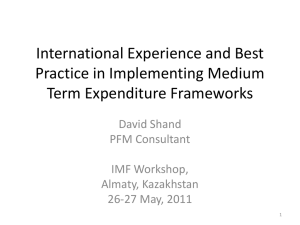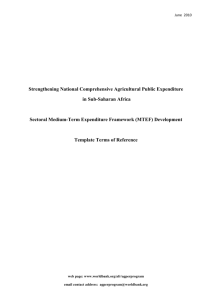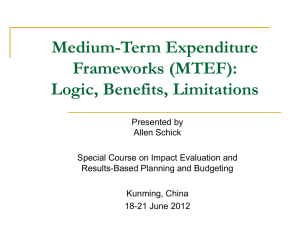PPT - University of Bradford
advertisement
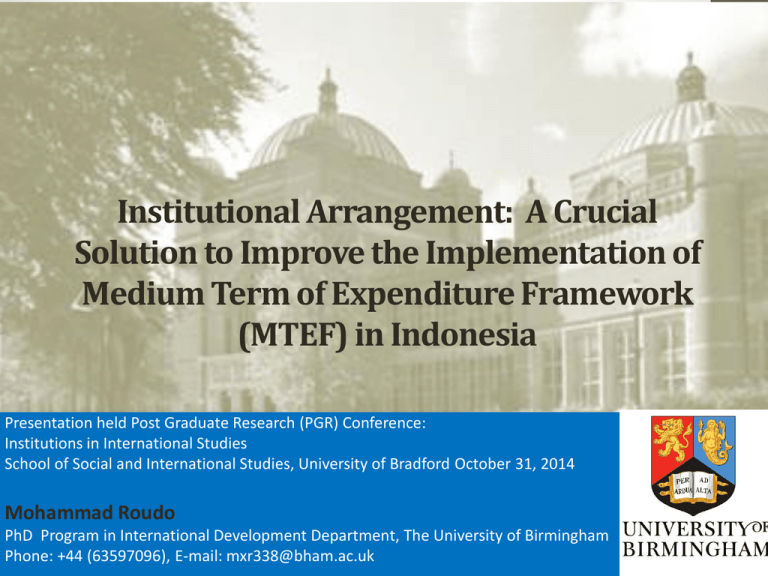
Institutional Arrangement: A Crucial Solution to Improve the Implementation of Medium Term of Expenditure Framework (MTEF) in Indonesia Presentation held Post Graduate Research (PGR) Conference: Institutions in International Studies School of Social and International Studies, University of Bradford October 31, 2014 Mohammad Roudo PhD Program in International Development Department, The University of Birmingham Phone: +44 (63597096), E-mail: mxr338@bham.ac.uk Outline Main Argument MTEF and 3 Elements of PEM/PFM Problems Solutions and Challenges Conclusion Main Argument MTEF in Indonesia is relatively effective to maintain the aggregate fiscal discipline but it is still questionable to deal with allocative efficiency issues The weakened role of the Minister/Ministry of Finance (MoF), caused by a dual budgeting system, and the increasing of roles of parliament are the main factors. Elements of PEM/PFM (Schick 1998; World Bank, 1998) Operational Efficiency This Element is not discussed in this paper (OF) Main Focus of Discussion 1.Significant and interesting development and challenges 2.Significant and direct contribution to the improvement of the quality of life of Indonesian people. Efficient way to utilize public money Allocative Efficiency (AE) Government strategies to effectively allocate the budget to pursue public goals Maintaining Aggregate Fiscal (AF) Efforts of government to spend beneath the total amount of money allowed MTEF in Indonesia Introduction tools on budgeting like the Medium Term Expenditure Framework (MTEF) were an obvious and essential change in Indonesia PEM/PFM reforms (The World Bank, 2012). MTEF is a tool that make the government more realistic and disciplined with their budget by linking policy priorities and budgets between 3 and 5 years (The World Bank, 1998; OCDE 2009) In Indonesia, MTEF has been applied since 2007 and set including predictions for following four years of budgets. MTEF significantly changes the way governments utilize their scarce resources and potentially guides the government towards a more transparent and rational management of public finance and resources, leading to the improvement of public services (Ministry of Finance, 2012). MTEF and 3 Elements of PEM/PFM (Ministry of Finance, 2012; The World Bank, 2008). OE This Element is not discussed in this paper AO Allocation budgets for non-priority programmes/activities (e.g. military spending and general/ local elections) have increased over the last five years In contrast, the budget increases for priority sectors are not as significant as the nonpriority sectors AF Has better rationalised its assumption of potential income Aware, careful and keep spending within the available resource envelopes The effectiveness of MTEF to estimate government revenue in Indonesia, A lower deficit in Indonesia’s overall budget , A decline in debt levels and unnecessary spending MTEF and Allocative Efficiency The weak role and power of the Minister/Ministry of Finance (MoF). A weak link between policy and the budget. the ineffectiveness of MTEF when dealing with allocative efficiency issues Why do the role and power of MoF become weakened? 1 Institutions are not matched to the logic of MTEF • A dual budget institution (a separate budget institution which creates bad coordination between recurrent and capital budget) • MoF Vs MoP (Bappenas) 2 An increase in the roles of parliament/house of representatives • Less sufficient capacities to deal with MTEF • Less political commitment to guard priority programmes/activities. Dual Budget Institution The Fact: 1.Currently, coordination is only made occasionally in particular events (e.g Trilateral Meeting) 2.A ‘white elephant project’ issue 3.Different perceptions to determine priority programmes 4.Check and balance mechanisms can still be set internally or by using external auditors (+) • Having a check and balance mechanism in budget allocation and the utilization of resource envelopes which will possibly to prevent the budget from being used inappropriately, address budgets to priority programmes and improve MTEF to optimally deal with allocative efficiency issues (-) • Weakened roles of MoF to making MTEF effectively deals with allocative efficiency issues • More possibility to have a duplication in both capital and recurrent budgets caused by lack of coordination • Lack of coordination could also cause drawing policy far to priorities Increasing Roles of Parliament The Fact: 1.Sometimes, this is not followed by an increase in capacity of parliament members on financial/budget issues 2.The discussions focus on the level of inputs , only in few cases, the budget allocation justification/judgement is made by parliament based on national priorities 3.Allocation based on national priorities becomes more difficult and MTEF becomes ineffective at dealing with allocative efficiency (+) (-) • It is an important progression for Indonesia’s democratic system acting as fiscal watch dog’ and ‘budget policemen’ ensuring that the state budget is allocated appropriately • The creation of checks and balances in budget allocation and formulation to the government • MTEF are rarely utilized as the basis for budget allocation • Moral hazard problems: the discussion of budget allocation is not about whether particular aims have been achieved or/and priority programmes have been addressed, but mostly how much money has been directed towards their constituents/ parties Solution 1: Integration planning and budget institutions Description Challenges • Ensure coordination between planning and budgeting • Strengthen the roles of MoF while facing other members of cabinets or even parliament • Better in dealing with allocative efficiency issues • An improvement in the connection between policy and budget • More focus on priority programmes • More efficient use of MTEF in tightly connecting capital and recurrent budget • The reluctance from politicians and senior managers who could possibly lose their position • Difficulties to make a clear division of functions, setting internal coordination and check and balance mechanisms as well as bbuilding the same perceptions in determining priority programmes • Require political support and commitment from elites Solution 2: Introduction of financial and performance information Description Challenges • FMIS should comprise all information about MTEF and performance, introduced to the parliament immediately and continually supplied • Parliament might ignore the information supplied • Require high political supports and commitment--Idea of ‘platforms’(focusing on particular interventions and clear sequences) • Open to the public so it can place pressure Conclusion • MTEF is the most important and progressive change in Indonesia’s PEM/PFM reforms. • Positive attainments in maintaining aggregate fiscal discipline: smaller deficits in the total budget, more accurate projection of future incomes, Less spending on unnecessary expenditure • The roles of MTEF in dealing with allocative issues are still challenging: there is significant money still allocated to non-priority programmes , less certainty and miscalculations in recurrent budgets. • The Problems of Institutions: Weakness of the Indonesian MoF, A weak link between policy and the budget , Ineffective MTEF when dealing with allocative efficiency issues. • Recommendations in Future Reforms • Integration of the budget institutions • The introduction of FMIS to parliament • What is required • Consider some constraints and challenges • Learning some lessons from international practices • Political support and commitment from political elites or even people pressure. References (1) • • • • • • • • • • • • • • • • Allen, R. (2009) The challenge of reforming budgetary institutions in developing countries. IMF Working Paper [on line] WP/09/96. Available from: http://blog-pfm.imf.org/files/wp09961.pdf [Accessed 16 October 2013]. Allen, R., Eckardt, S., and Jacobs, J. et al (2007) Budget Reform Strategy Priorities: Final Report. Indonesia: IMF and World Bank [on line], 69791. Available from: https://openknowledge.worldbank.org/bitstream/handle/10986/13005/697910ESW0P1050es00June0200700with0.pdf?sequence=1 [Accessed December 2, 2013]. Allen, R., Hemming, R., and Potter, B.H. (2013) “Introduction: the meaning, content and objectives of public financial management.” In Allen, R., Hemming, R., and Potter, B.H. (ed.) The International Handbook of Public Financial Management. England: Palgrave Macmillan, p. 1-10. Andrews, M., and Campos, J. E. (2003). The Management of Public Expenditures and Its Implications for Service Delivery. Washington: The World Bank. Available from: http://wwwwds.worldbank.org/external/default/WDSContentServer/IW3P/IB/2003/11/10/000112742_20031110181026/additional/310436360_2005027602335 4.pdf [Accessed December 3, 2013]. APCoP-MfDR (2011) Framework for Results-Based Public Sector Management and Country Cases [on line]. Asia Pacific Community of Practice on Managing for Development Results Final Reports. Manila: Asian Development Bank. Available from: http://www.oecd.org/dac/peerreviews/Asia%20pacific%20cop%202011%20Framework%20for%20RBPSM%20and%20Country%20Cases.pdf [Accessed December 2, 2013] Bawono, I.R., and Hali, A. (2012) “Public sector performance measurement and budget allocation: an Indonesian experiment.” In Palmerston North: Management Accounting Conference. New Zealand, 23 November 2012. Available from: http://ir.canterbury.ac.nz/bitstream/10092/7485/1/12642198_NZMA2012%20Rangga%20Bawono%20et%20al.pdf [Accessed 5 December 2013]. Blondal, J.R., Hawkesworth, I., and Deok Choi, H. (2009). Budgeting in Indonesia. OECD Journal on Budgeting. 2009 (2): 1-31. Bowman, J.S., and West, J.P. (2007). Lord Acton and employment doctrines: absolute power and the spread of art will employment. Journal of Business Ethics. 74 (2): 119-130. Brumby, J., and Hemming, R. (2013) “Medium Term Expenditure Framework.” In Allen, R., Hemming, R., and Potter, B.H. (ed.) The International Handbook of Public Financial Management. England: Palgrave Macmillan, p. 219-236. Coombs, H. M. and Jenkins, D, E (2002) Public sector financial management. 3rd ed. The United Kingdom: Thompson Learning. De Bruijn, H. (2007) Managing performance in the public sector. 2nd ed. London: Routledge. Diamond, J. (2013). “Policy formulation and budget process.” In Allen, R., Hemming, R., and Potter, B.H. (ed.) The International Handbook of Public Financial Management. England: Palgrave Macmillan, p. 193-218. Hanifah, A. (2013). Indonesian President vows to increase education budget, prioritize infrastructure, cut deficit. In: China-English.news.cn. Available from: http://news.xinhuanet.com/english/indepth/2013-08/16/c_132637340.htm [Accessed 5 December 2013]. Holmes, M., and Evans, A.(2003). A Review of Experience in Implementing Medium Term Expenditure Frameworks in A PRSP Context: A Synthesis of Eight Country Studies [on line]. London: Overseas Development Institute. Available from: http://www.internationalbudget.org/wp-content/uploads/AReview-of-Experience-in-Implementing-Medium-Term-Expenditure-Frameworks-in-a-PRSP-Context-A-Synthesis-of-Eight-Country-Studies.pdf [Accessed December 4, 2013]. Key, V. O. (1940) The lack of budgetary theory, The American Political Science Review, 34 (6): 1137-1144. Lienert, I. (2013) “Role of legislature in budget process.” In Allen, R., Hemming, R., and Potter, B.H. (ed.) The International Handbook of Public Financial Management. England: Palgrave Macmillan, p. 116-135. References (2) • • • • • • • • • • • • • • Ljungman, G. (2009) Top down budgeting: an instrument to strengthen budget management. IMF Working Paper [on line] Washington: International Monetary Fund. WP/09/243. Available from: http://www.imf.org/external/pubs/ft/wp/2009/wp09243.pdf [Accessed 9 January, 2014]. MacIntyre, A. (2003) The power of institutions: political architecture and governance. Ithaca: Cornell University Press. Ministry of Finance (2012). The Indonesia Budget Overview 2011. Jakarta: Directorate General of Budget, Ministry of Finance. Available from: http://www.anggaran.depkeu.go.id/content/Publikasi/TIBO%202012%20English.pdf. [Accessed 3 December 2013] OCDE (2009). Task Force for the Implementation of the Environmental Action Programme for Central and Eastern Europe, Caucasus and Central Asia Regulatory Environmental Programme Implementation Network: Introduction to Medium Terms Expenditure Framework (MTEF) [on line] Organisation de Coopération et de Développement Économiques: Briefing Note ENV/EPOC/EAP/REPIN(2009)2. Available from: http://www.oecd.org/env/outreach/42942138.pdf [Accessed December 9, 2013]. Premchand, A. (1993) Public expenditure management. Washington: International Monetary Fund. Sarraf, P. (2005) Integration of recurrent and capital ‘development’ budgets: issues, problems, country experiences. Public Expenditure Working Group .Washington: The World Bank. Available from:http://www1.worldbank.org/publicsector/pe/StrengthenedApproach/CapitalRecurrentIntegration.pdf [Acessesed 4 December 2013]. Schick, A. (1998), A Contemporary Approach to Public Expenditure Management [on line]. Washington: The World Bank. Available from: http://www.mof.go.jp/international_policy/research/fy2005kenkyukai/1803pfm_16.pdf [Accessed: October 31, 2013]. Suryabrata, W. (2005) Planning and Budgeting Reforms in Indonesia: Past Achievements and Future Challenges. Indonesia: Ministry of National Development Planning. Available from: https://www.google.co.uk/#q=Suryabrata%2C+W.+2005.+Planning+and+Budgeting+Reforms+in+Indonesia%3A+Past+Achievements+and+Future+C hallenges.+Ministry+of+National+Development+Planning.+Indonesia. [Accessed December 2, 2013] The World Bank (1998) Public Expenditure Management Handbook [on line]. Washington: The World Bank. Available from: http://www1.worldbank.org/publicsector/pe/handbook/pem98.pdf [Accessed 14th October, 2013] The World Bank (2007). Public Expenditure and Financial Accountability: Public Financial Management Performance Reports and Performance Indicators [on line]. Report No. 42098 ID. Indonesia: The World Bank. Available from: http://wwwwds.worldbank.org/external/default/WDSContentServer/WDSP/IB/2008/07/09/000333038_20080709060448/Rendered/PDF/420980ESW0P1061N LY10Indonesia0Final.pdf [Accessed 2 December, 2013]. The World Bank (2008) Spending for Development Making the Most of Indonesia's New Opportunities: Indonesia Public Expenditure Review. [on line] Washington: The World Bank. Available from: http://wwwwds.worldbank.org/external/default/WDSContentServer/WDSP/IB/2008/02/18/000333037_20080218021652/Rendered/PDF/425300PUB0ISBN1Sa me0as0report038772.pdf [Accessed: 5th December 2013]. The World Bank (2012). Indonesia: Repeat Public Expenditure and Financial Accountability (PEFA) Report and Performance Indicators. Jakarta: Public Financial Management Multi Donor Trust Fund for Indonesia. Wehner , J., and de Renzio, P. (2013) “Designing fiscal institutions: the political economy of PFM reforms.” In Allen, R., Hemming, R., and Potter, B.H. (ed.) The International Handbook of Public Financial Management. England: Palgrave Macmillan, p. 84-95. Wijaya, A.S. (2013) Playing Defense in the State Budget. Tempo [on line] Friday, 16th August. Available from: http://en.tempo.co/read/news/2013/08/16/056504941/Playing-Defense-in-the-State-Budget [Accessed 3 December 2013]. THANK YOU
